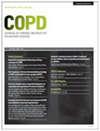Potential Explanatory Factors for the Concurrent Experience of Dyspnea and Pain in Patients with COPD
IF 2.1
4区 医学
Q3 RESPIRATORY SYSTEM
COPD: Journal of Chronic Obstructive Pulmonary Disease
Pub Date : 2022-06-06
DOI:10.1080/15412555.2022.2081540
引用次数: 1
Abstract
Abstract Previous research has identified unexpectedly strong associations between dyspnea and pain, but the reasons remain unclear. Ascertaining the underlying biological and psychological mechanisms might enhance the understanding of the experience of both conditions, and suggest novel treatments. We sought to elucidate whether demographic factors, disease severity, psychological symptoms and biomarkers might account for the association between pain and dyspnea in individuals with COPD. We analyzed data from 301 patients with COPD who were followed in a prospective longitudinal observational study over 2 years. Measures included self-reported dyspnea and pain, pulmonary function tests, serum levels of inflammatory cytokines, measures of physical deconditioning, and scales for depression and anxiety. Analyses involved cross-sectional and longitudinal linear regression models. Pain and dyspnea were strongly correlated cross-sectionally (r = 0.77, 95% CI 0.72–0.82) and simultaneously across time (r = 0.42, 95% CI 0.28–0.56). Accounting for any of the other health factors only slightly mitigated the associations. Symptoms of pain and dyspnea thus may be fundamentally linked in COPD, rather than being mediated by common biological, psychological, or functional factors. From the patient’s perspective, pain and dyspnea may be part of the same essential experience. It is possible that treatments for one condition would improve the other.COPD患者并发呼吸困难和疼痛的潜在解释因素
先前的研究已经发现了呼吸困难和疼痛之间出乎意料的强烈联系,但原因尚不清楚。确定潜在的生物学和心理学机制可能会增强对这两种情况的理解,并提出新的治疗方法。我们试图阐明人口统计学因素、疾病严重程度、心理症状和生物标志物是否可能解释慢性阻塞性肺病患者疼痛和呼吸困难之间的关联。我们分析了301名COPD患者的数据,这些患者在一项前瞻性纵向观察研究中随访了2年多。测量包括自我报告的呼吸困难和疼痛、肺功能测试、血清炎症细胞因子水平、身体降条件测量以及抑郁和焦虑量表。分析包括横截面和纵向线性回归模型。疼痛和呼吸困难在横断面上呈强相关(r = 0.77, 95% CI 0.72-0.82),同时在时间上呈强相关(r = 0.42, 95% CI 0.28-0.56)。考虑到任何其他健康因素只能略微减轻这种关联。因此,疼痛和呼吸困难的症状可能与COPD有根本联系,而不是由常见的生物、心理或功能因素介导。从患者的角度来看,疼痛和呼吸困难可能是同一基本体验的一部分。对一种情况的治疗可能会改善另一种情况。
本文章由计算机程序翻译,如有差异,请以英文原文为准。
求助全文
约1分钟内获得全文
求助全文
来源期刊

COPD: Journal of Chronic Obstructive Pulmonary Disease
RESPIRATORY SYSTEM-
CiteScore
4.40
自引率
0.00%
发文量
38
审稿时长
6-12 weeks
期刊介绍:
From pathophysiology and cell biology to pharmacology and psychosocial impact, COPD: Journal Of Chronic Obstructive Pulmonary Disease publishes a wide range of original research, reviews, case studies, and conference proceedings to promote advances in the pathophysiology, diagnosis, management, and control of lung and airway disease and inflammation - providing a unique forum for the discussion, design, and evaluation of more efficient and effective strategies in patient care.
 求助内容:
求助内容: 应助结果提醒方式:
应助结果提醒方式:


